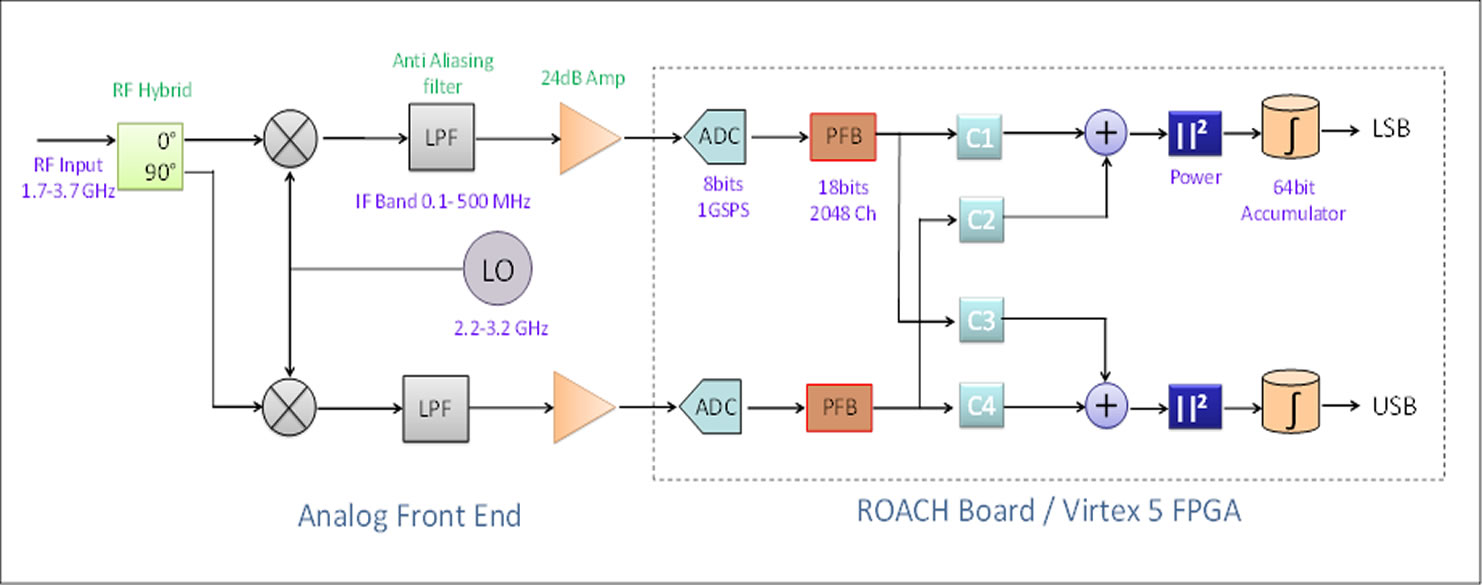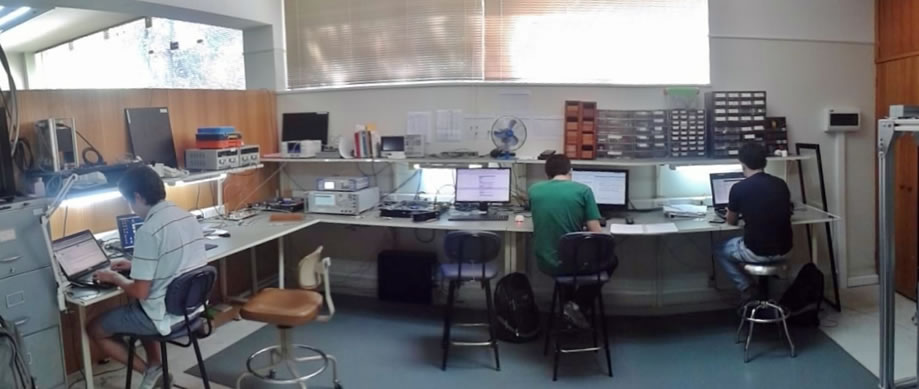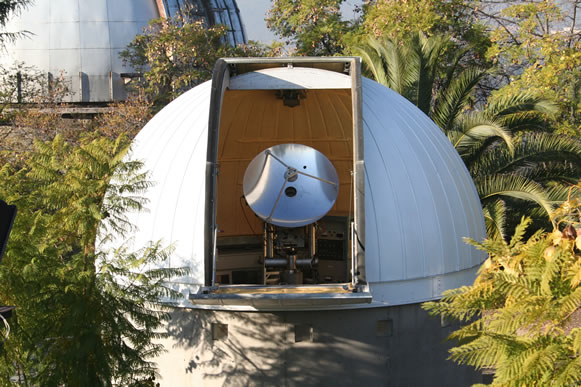Concluded Project
Development of a Prototype for Band 1 (31-45GHz).
The Atacama Large Millimeter Array (ALMA, http://www.almaobservatory.org/) is the largest radio astronomical array ever constructed. Every one of its antennas will cover the spectroscopic window allowed by the atmospheric transmission at the construction site with ten different bands. Despite being declared as a high scientific priority by the ALMA Scientific Advisory Committee, band 1 was not selected for construction during the initial phase of the project. However, Universidad de Chile is running a program for the construction of a prototype receiver for band 1 of ALMA. The first prototype has already been build and tested at cryogenic temperatures.
| ALMA Band 1 prototype | ||||||
|
||||||
New receiver for MINI (80-115 GHz)
During the last years, the front end
of the receiver of the MINI has been upgraded in several important
ways. However, the receiver still maintains the double sideband
(DSB) configuration. With the telescope being change to a new site
with lower atmospheric transmission, a new more fundamental upgrading
becomes more import namely using a sideband separating configuration.
This upgrading is important due to the characteristic that 2SB receivers
distinguish between the image and signal sidebands can be exploited
in astronomy by providing enhanced atmospheric noise reduction when
compared with DSB receiving techniques. To complement the front-end
upgrading, we are constructing and integrating a digital correlator
with IF hybridization capabilities.
Simulation of the electromagnetic performance of one of the waveguide
components (known as hybrid) necessary to obtain sideband
separation. The signal entering the hybrid by the upper right
port is divided in signals having equal amplitude but 90°
phase difference. |
A calibrated digital sideband separating spectrometer for radio astronomy applications.
High image rejection receivers are of particular interest at places where the atmospheric noise contribution is high or when radio frequency interference is present. It is also important when the radio source is complex having many/broad spectral lines. Unavoidable gain and phase imbalances strongly limits the achievable sideband rejection ratio of analog instruments to about 10-20dB for high sensitivity, broadband receivers. The increasing power of digital processing hardware has opened the door for a new approach which is based on performing the IF recombination using digital technology. This method allows correcting the amplitude and phase imbalances of the analog front end in the digital back end to achieve high sideband rejection ratios.
We are working in the implementation of a digital sideband separating FFT spectrometer using a FPGA-based platform called the ROACH (Reconfigurable Open Architecture Computing Hardware). The ROACH is developed by the CASPER group (Berkeley). Two ROACH boards were acquired and fitted with Virtex-5 chips thanks to the donation of Xilinx Inc. The results of the research were very positive showing an important improvement with respect to current analog technology. The next step is to test the new spectrometer on the 1.2m mm-wave telescope and to search for new instruments to integrate the technology.
Figure
1: Digital Sideband Separating Spectrometer (DSSM) block diagram. |
|
Figure
2: Millimeter Wave Laboratory Back End area. |
MINI 115GHz Radio-Telescope
The relocation from Cerro Tololo Observatory to Cerro Calán and an upgrade to the receiver of the MINI radio-telescope is another activity of RAIG. MINI was installed in Cerro Tololo in 1982. A twin MINI telescope is on the roof of -Building D- at the Harvard College Observatory. Together, these two instruments have obtained what is by far the most extensive, uniform, and widely-used Galactic survey of interstellar carbon monoxide (CO), the best general tracer of the largely invisible molecular hydrogen that constitutes most of the mass in molecular clouds. In 2005, the receiver was moved to the Millimeter Wave Laboratory of Cerro Calán to upgrade the Front End and the LO. The 1.2m dish, the dome and the spectrographs were moved in mid-2009 and installed in a new building in mid-2010. First light was obtained on Nov 18, 2010. Regular observations with MINI will start soon. We plan astronomy students to get hands on experience with radio telescopes and electrical engineers to develop technological research. For example, the development of a new digital backend for MINI and the upgrade from DSB to SSB receiver.
| MINI radio-telescope installed in Cerro Tololo in 1982 | ||||||||
|
||||||||
ALMA Band 5
ALMA band five covers the frequency window from 163 to 211 GHz including the water line of 183 GHz. The Band 5 receivers are under construction at the Group of Advanced Receiver Development (GARD) on Chalmers University. The first receiver is getting ready for integration at the European Front End integration Center (EuFEIC) in UK, and it will be delivered to ALMA at the beginning of 2011. The Department of Astronomy of the University of Chile (DAS) is part of the consortium for the development of the first 6 receivers providing skilled engineering labor at the EuFEIC and GARD. DAS will be responsible for the integration and verification of the receivers in Chile.
| RF probe for band 5 Beam Scanner Test Source (BeaSTS) | ||||||
|
||||||
Cursos
- EL3002 - Electromagnetismo Aplicado
- EL3004 - Circuitos Electrónicos y Analógicos
- EL4002 - Sistemas Digitales
- EL4108 - Principios de Instrumentación
- EL5208 - Laboratorio de Receptores, Antenas y Señales
- EL6001 - Física de Dispositivos Semi-Conducotres y de Estado Sólido
- EL7026 - Sistemas de Instrumentación
- EL7029 - Microondas
- EL7030 - Antenas
- EL7108 - Dispositivos Ópticos y Fotónicos
- AS3103 - Óptica para Científicos/as e Ingenieros/as
- AS4201 - Astronomía Experimental

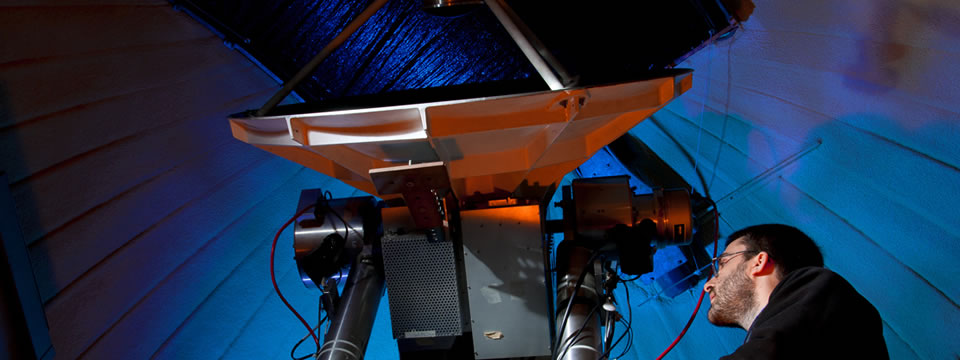
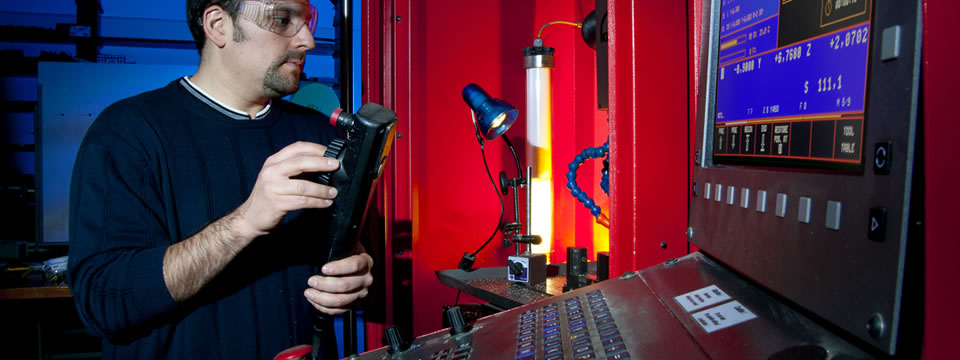
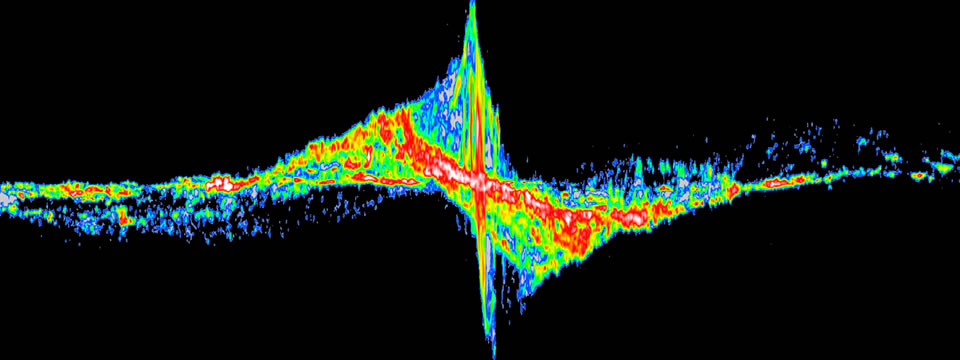

.gif)
